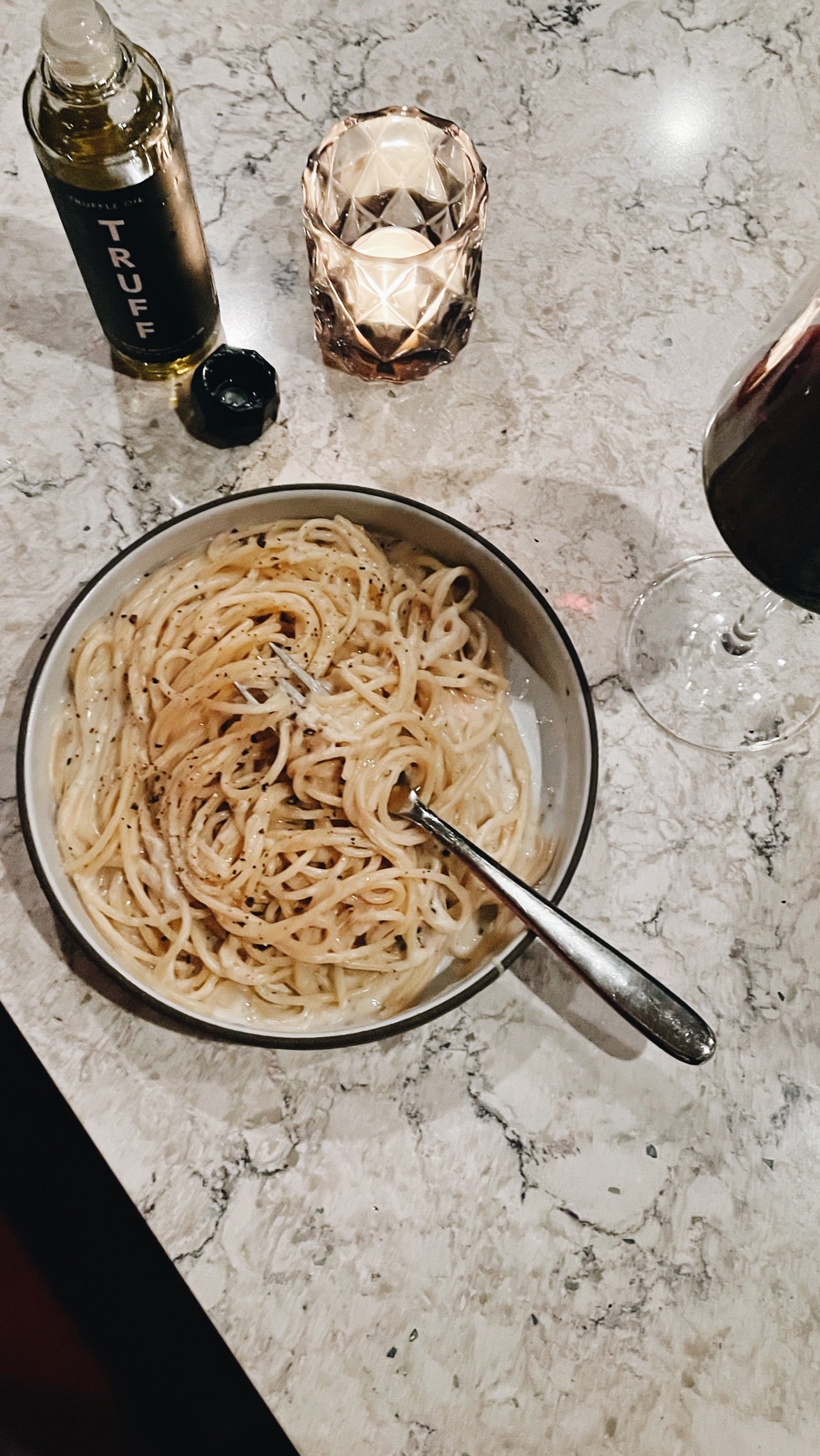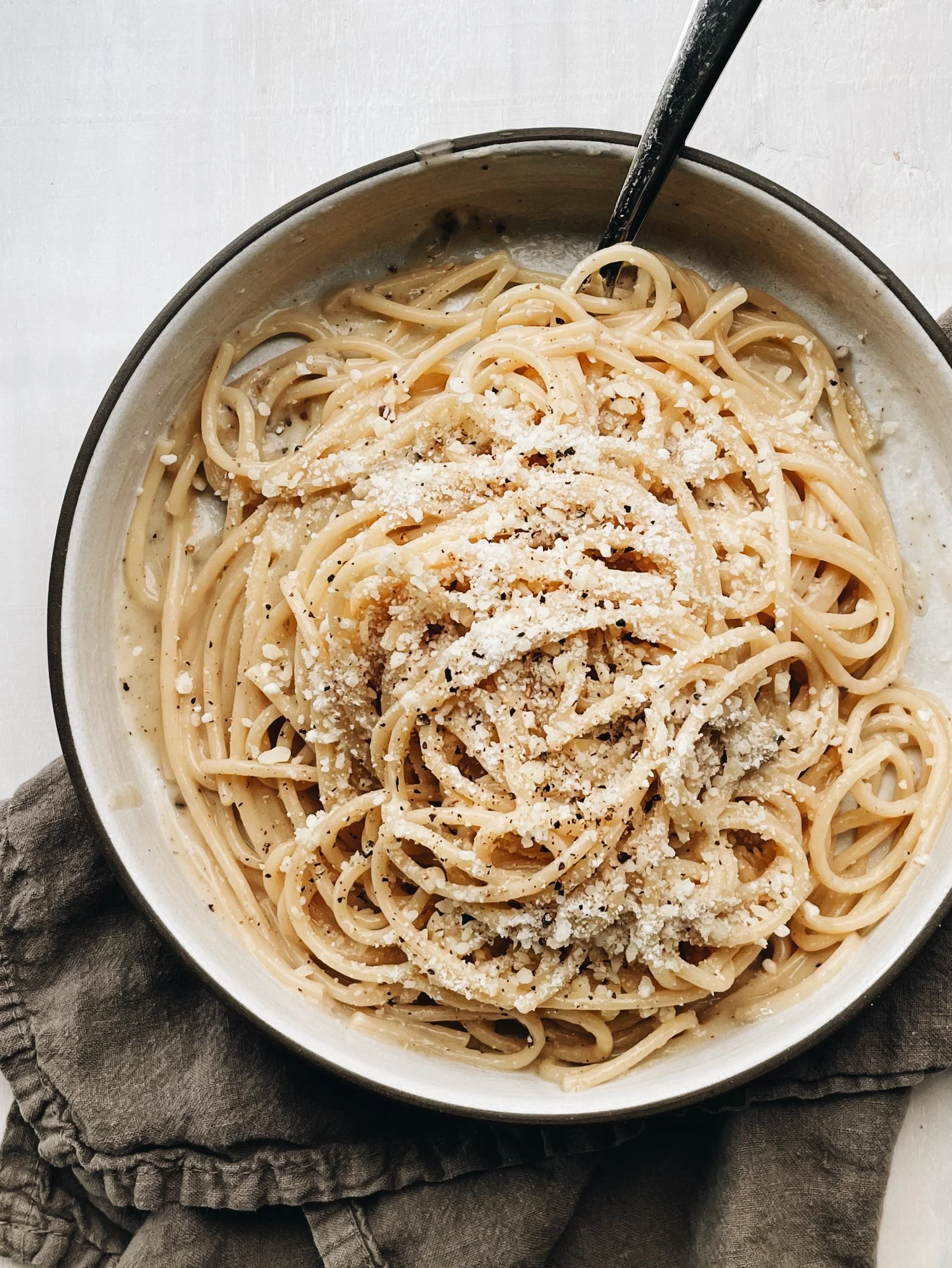cacio e pepe for one
Usually my “for one” recipes are about learning to like being alone, but this one is about making yourself less lonely in the event you find yourself alone while in a relationship.
The worst part of being in a long-distance relationship wasn’t that final 24 hours of preemptive sadness, or trudging like a zombie at 7am through the airport dragging the weight of my life and Doc Martens behind me, but getting home to an empty lightless house, which I would now have to fill by myself despite feeling less complete than ever. Staring down a fridge full of nothing but hot sauces and jarred kimchi and a half-empty tub of pecorino cheese, it’s easy to feel like you have very little in the world, least of all your shit together.
But even in that moment, you have enough for cacio e pepe—and if you have cacio e pepe, then you have all you could ever need.
Cacio e pepe is a very traditional recipe that doubles as Roman drunk food, meaning it’s humble, casual, and never expected to be too perfect. But while it takes only 3 ingredients (5 if you count water and salt), it does take a certain amount of skill to be edible, and to be honest, I’ve historically had trouble executing this dish consistently enough to ever justify writing down. Gloppy broken cheese glued into the bottom of the pan is not exactly going to boost your self-esteem as a Totally Capable Independent Whole Person, and unfortunately a lot of the techniques I’ve read about and tried seem to produce that result for me. Botched cacio is the kind of depressing symbol of futility and failure—it’s so simple, what’s wrong with you?—that has had me fighting back tears at the sink while I consider throwing away my cookware rather than deal with cleaning it up.
This technique, however, is very hard to mess up. It’s almost the same trick as my method for perfect carbonara, which is undoubtedly the harder of the two. Like the carbonara, cacio is easiest to do in two pots, though it’s theoretically possible to do it in one. You boil the pasta in one pot until you reach a crunchy al dente, then transfer it to a skillet where toasted coarsely-grated black pepper (no oil, you just toast it dry right in that pan) awaits. Using a little measuring cup, you scoop pasta water from the big pasta pot to the smaller skillet and cook a few minutes longer. While that finishes up, you also temper your grated pecorino by adding a small amount of pasta water to it, whisking it together with a fork into a cloudy white paste. Once it’s time to combine, the cheese and water are already emulsified, meaning all you have to do is twirl the pasta mass onto a pair of tongs and mop it around a few times to really get all that sauce properly distributed. You add pasta water for additional fluidity as you go.
Cacio e pepe is also, like most Italian recipes, personal to some extent. I like a looser cacio, one with a freer-flowing sauce that pools off the pasta, with a sneeze-inducing quantity of pepper grated extremely coarsley. This recipe makes exactly that. If this does not sound like your idea of a Good Time, tweak it to make it your own: increase the ratio of cheese to pasta water to make it tighter and less saucy (or use less cheese to do the opposite), grate less pepper on a finer grind if you’re sensitive. I do ask that you use Pecorino Romano at least once, only because it’s the one ingredient bringing complexity to the table—without it, this dish is so simple that it actually is kind of boring, or at least as boring as pasta with cheese on it can ever really be.
I’ve had it at restaurants, I’ve had it in Rome, I’ve had it made by skilled hands and unskilled hands, and while all cacio is good (and some is great), this is as close as I’ve been able to get to replicating the best I’ve ever had, and all for myself. And no matter what void you have—in your pantry, in your fridge, in your life—as long as you have pecorino and pasta and pepper, then you will have something delicious with which you can fill it.
For a little something extra special, try a drizzle of high-quality truffle oil at the end. It’s no longer cacio e pepe, but I will call it cacio e pepe e tartufe and I don’t want to hear any complaints.
RECIPE
A foolproof, heavily-tested technique for traditional Roman 3-ingredient cacio e pepe, designed for the most important person in your life: you. Serves one on purpose, but don’t let that stop you from doubling it.
Effortful time: 5 minutes?
Total time: 15 minutes
Serves one very generously
YOU NEED
4 oz. spaghetti, preferably one on the thicker side
1/3 cup grated pecorino romano cheese
Black pepper, freshly and very coarsley ground—I maybe do a tsp. total, but use whatever quantity that suits you
A lot of that starchy pasta water
make it
Cook the pasta. Bring water to a boil in a pasta pot. Use a little less salt than you might otherwise. Cook your pasta for 3 minutes under the package directions.
Toast the pepper. Heat a small skillet over medium heat. After grinding your pepper, add all of this to the pan—that’s right, no oil—and let it gently toast, moving it around with tongs until you smell a strong pepper fragrance. This takes about 30 seconds, so time it according to when you’ll want to pull your pasta.
Finish the pasta in the skillet. Using tongs, transfer the pasta straight into the skillet with the pepper. Do not drain the pasta pot; this starchy water is now your mixing medium. Use a small dry-measuring cup to scoop some pasta water out of the pot and pour it over the pasta in the skillet. Continue cooking the pasta until it reaches al dente, using tongs to stir it up, about 3 minutes longer.
Make the cheese “sauce” base. In a bowl or another measuring cup, add the pecorino cheese. Use your measuring cup to again ladle a small amount of pasta water into the cheese, and use a fork to beat it into a paste.
Combine and toss. When the pasta is al dente (there should be very little water left in the pan) and the cheese is combined in the cup, lower the skillet’s heat to low. Pour the cheese mixture all over the pasta, then use your tongs to pull the entire “mop” of pasta around in the pan, tossing it together over the heat until it begins to combine. I needed more pasta water to do this; just keep a scoop handy next to your pasta water and keep adding as you go. If it’s looking too wet, or isn’t binding, add a bit more cheese. If it looks dry, add more water. If you slightly overshot your pasta quantity and there just isn’t enough sauce, try adding a little more of both water and cheese.
Finish and serve. Shower with freshly ground black pepper, a little more pecorino, a glass of wine, and maybe even a drizzle of truffle oil just to keep the rules on their toes.



